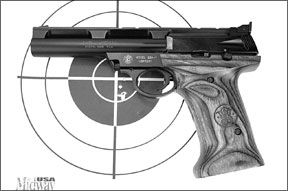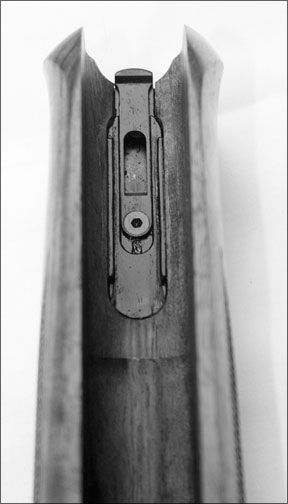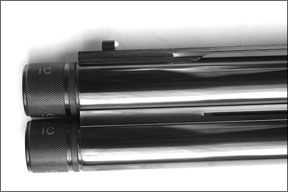We’ve recently had a chance to shoot two guns one .22 LR pistol and a pricey over-under 12 gauge against guns we’ve already tested.

In the January 2007 issue, we reviewed Ruger’s 22/45 Mark III KP512MKIII .22 LR, $398, and Browning’s Buck Mark FLD Plus Rosewood UDX 051429490 .22LR, $417. Since then, we had a chance to shoot the Smith & Wesson 22A-1 107431 .22 LR, $427. Each of these guns featured a 5.5-inch heavy barrel. We shot the 22A-1 head to head against those other guns still in our inventory, and we wanted to update Gun Tests readers on how the third gun fit into the picture.
Likewise, we tested two midrange-price sporting-clays over/unders in the November 2006 issue: the Blaser F3 Competition Sporting, $5195; and Beretta’s 687 EL Gold Pigeon II Sporting No. J687526, $5495. Against the two original test guns we pitted the Caesar Guerini Maxum Sporting, $4950, to see how it stood up.
Here’s what we found:
Smith & Wesson 22A-1 107431 .22 LR, $427
As in the previous test, we shot each pistol for accuracy at American Shooting Centers in Houston and performed additional tests for endurance and reliability at Top Gun Range. Our choice of test ammunitions were Remington 36-grain brass-plated hollowpoints, CCI Green Tag 40-grain Competition Ammunition, and Federal American Eagle 40-grain solids.
Aside from the $1100-plus high-end models listed on the smith-0207_Waltherstock.jpgwesson.com website, our Smith & Wesson 22A-1 was the second most expensive rimfire pistol. Our pistol had a fancy composite wood target grip that featured an oversize magazine well that gave it big gun ergonomics. But inserting the magazine meant having to reach up into the magazine well and burying the basepad with your fingertips.

Magazine release was via a button recessed into the front strap. This seemed odd at first, but after shooting the 22A-1, we began to like the feel of the gun because it accurately replicated a full-size pistol with full beavertail reaching over the web of the shooter’s hand.
Another feature that seemed unnecessarily large but worked well was the sights. The rear sight blade was large in area and the front sight seemed too fat. But at the range, we found it easy to land small groups without straining our eyes.
Not every aspect of the Smith & Wesson 22A-1 was unusual or oversized. The bull barrel was topped with a Weaver-specification rib that integrated both the front sight blade and the fully adjustable rear unit. The rib made mounting a scope very easy without having to remove the metallic sights. The slide release was a flat paddle on the left side that was also convenient. The safety was just ahead of the right-hand thumb, but its location couldn’t help overcome the amount of resistance necessary to move it up for safety-on nor downwards for safety-off, ready to fire.
Frustrated with the safety, we resorted to clearing the weapon and leaving the slide locked open each time we put the gun down. The magazine was easy to load, thanks to a bar on the left side of the magazine that could be used to draw down the follower. Two stainless steel magazines with removable basepads were provided. Capacity was 10 rounds.
The trigger was smooth and consistent at about 4.5 pounds. If the big-bodied grip of the Smith & Wesson 22A-1 wasn’t our cup of tea out of the box, then we learned to love it pretty quick. We settled in to our sandbag rest with a dose of skepticism due to the large gauge sights. But as we fired group after group, it became apparent that the sights were well suited to this pistol and results topped its competitors in this test, but not by much.
Each of our test guns landed average groups measuring 1.1 inches firing the Remington ammunition. The CCI Green Tag shot best in the Smith & Wesson by 0.1 inches over the Ruger and bested the Browning by 0.2 inches. Average results with the stubborn shooting Federal rounds were 1.3 inches for the 22A-1 versus 1.4 inches and 1.5 inches for the Ruger and Browning pistols respectively.
If accuracy was not going to determine a winner then perhaps handling and maintenance issues would. When it came to servicing the gun, the main concern is always to keep the chamber mouth and breech face areas clean. The extent to which the pistol should be disassembled by anyone but a certified Smith & Wesson armorer was described in the owner’s manual under field stripping. This was very simple.
With the gun cleared and the slide locked back, the gun is held with one hand on the pistol grip and with the other hand over the barrel so that the thumb contacts the takedown panel found just in front of the trigger guard. Pushing in the takedown panel allowed the barrel assembly including the sight rail to be lifted free. The slide and recoil spring can then be removed. We found this design to allow for easy access to all parts that required cleaning and lubrication. Replacing the barrel started with hooking the rear of the top end behind the recoil spring assembly, pressing in on the takedown panel and seating the barrel into the frame. How often the gun is to be cleaned would likely depend on round count and the type of ammunition used. We did not suffer any malfunctions other than with the Federal ammunition, which the other guns had trouble with as well.
Caesar Guerini Maxum 12 Gauge, $4950
As in the November 2006 test, we shot several hundred rounds through the Guerini on several different sporting clays courses offering a variety of difficulty levels. For accuracy, we shot the Guerini standing at 40 yards as measured by a Bushnell rangefinder (as if for patterning) and from the Shooter’s Ridge Steady Rest on Midway USA’s MTM portable shooting bench for point-of-impact tests, using the National Target Company’s shotgun patterning target (both proved accurately regulated). Trigger pulls were measured by an RCBS trigger-pull gauge provided by Midway USA.
This is a relatively new maker to the shotgun game in general, but boy has it made a splash, partly because the guns are quickly gaining a reputation for great out-of-the box fit and excellent finish, yet with more than reasonable prices for what buyers are getting in a gun (a good portion of hand finishing substitutes for what would normally be machining in other gun lines).
The Maxum is second to the top of a seven-tier grade lineup from Caesar Guerini. Only the maker’s Forum costs more, and that’s pretty much solely due to its hand engraving. The Maxum has hand-finished engraving in a deep relief, full-coverage, gothic scroll style. Some will say it’s busy; we think it’s superbly done, from its false sideplates to the top tang to the trigger guard.
Guerini’s website says the stock on the Maxum is a deluxe grade of Turkish Circassian walnut. It’s certainly a good grade, well striped, with a deep cherry color on our sample. But we’d like to see a slightly better piece on a gun close to $5,000. It’s not a bad stock for this price range, but we think it could have been fancier. The finish however, could not be better done. At first glance it looks like a low-gloss finish. It’s not. It’s oiled and hand-rubbed to a beautiful sheen. This will wear with repeated handling, as to be expected, but Guerini offers a special care program we’ll talk about more in a bit, so this isn’t really a problem.

Checkering at the wrist and forend is tighter than the Beretta at 26 lines per inch, and it’s better done on the Guerini. The cuts are deeper, cleaner, and sharper, offering more purchase to an ungloved hand. There’s also no noticeable runover at the points and corner, as there was with the EL Gold Pigeon. There’s a palm swell on the right of the stock, apparent, but it fit comfortably in a small palm. We found it actually aided proper hand position.
The overall wood-to-metal fit was better than the Beretta. Not only were there no unstained edges at the inletting, Guerini took the time to flush the wood to the scalloping at the fences and the front of the top tang: Beretta left the wood edge raised and exposed (albeit at least fully stained in that place).
In handling, this is a very different gun from the Beretta. More responsive on fast transitions, we thought the balance to be forward, as it should be, though not quite as much as the Beretta. Now, part of that was because we shot this gun with 30-inch barrels. But this gun also doesn’t weigh as much overall, so it’s more accommodating to shooters who aren’t built like lumberjacks. Only a few big-and-tall shooters we handed it off to for testing actually felt the gun was too light. Most of the response from all sizes was more on the order of “Wow!” We concur, we just love to shoot this gun.
As with the Beretta, there were no mechanical issues. All loads worked equally well, the safety and barrel selector take positive action, and the trigger is satisfactorily sharp. The trigger is also adjustable for length of pull, and the gun does not auto safe. We did shout “Hooray!” that it came with extended choke tubes, these in blue like the barrel so they don’t scream “Hey, that gun has extended choke tubes!”

Fit is everything in a shotgun; we don’t care if it’s a $500 gun or a $50,000 gun. Buyers should never expect to have a gun fit them perfectly out of the box, and experienced shooters usually know that some modification to the stock will be in order with a new gun. The three in our lineup will be no different, though comments we’ve heard from people sampling Guerinis indicate that a lot of shooters are comfortable with their Guerini sporting clays guns right off the bat and seeing increased scores with minimal or no alteration. To us, that speaks volumes about this gun line.
What is perhaps the most winning facet of the Guerini is the company’s “Pitstop” maintenance program. For the cost of just shipping, you’ll send your gun once a year back to the company and they will go over the gun completely, replacing just about anything that needs to and is not part of normal wear and tear, and doing things like sweating out dents in the stock and re-rubbing it back to its original sheen. In five to seven days you’ll have your gun back nearly as new as the day you bought it, and all it will have cost you was a UPS fee. That’s exceptional service these days, and when we look at this gun’s price tag being the least expensive of the trio, we think that more than qualifies this gun for a best buy.
Our Team Said
Beretta EL Gold Pigeon II Competition Sporting, $5495, was a Conditional Buy. We really loved the way this gun shot and its looks, but the particular way the Beretta balances will probably narrow the field of who will find it beneficial to raising their score. Try before you buy, if possible.
We thought the Blaser/SigArms F3, $5195, was a Best Buy. Clean good looks, outstanding handleability, extended choke tubes, an integral fiber optic sights, dual stock configurations to choose from, the Balancer weight distribution system, and an array of equally weighted barrels make the F3 a complete package that’s worth the steeper price tag. The only ones who won’t like it are those looking for the fancier look of the Guerini and Beretta.
Caesar Guerini Maxum, $4,950. Best Buy.Like the F3, the Maxum is excellent value for the money. It handles cleanly, is snappy when it needs to be, and ultimately a great joy to shoot. It’s also extremely well fitted and handsomely appointed, and with the company’s no cost, fix-it-once-a-year policy, the Maxum is an excellent buy for those wanting to move up from a basic competitive gun without going clear to the five-figures mark.
Don’t Buy the Ruger 22/45 Mark III .22 LR, KP512MKIII, $398. We thought an overly complex take down/reassembly procedure might ultimately keep this gun in the closet. We gave the Browning Buck Mark FLD Plus Rosewood UDX .22 LR 051429490, $417, a Buy It rating. Simple maintenance, great looks and accurate, this gun made us want to go to shooting.
Smith & Wesson 22A-1 .22 LR 107431, $427. Conditional Buy. The oversize grip may put off some buyers, but only those with very small hands will not be able to use it effectively. This was the easiest gun to shoot accurately and maintain, but the safety was too difficult to operate, in our view.
Written and photographed by Roger Eckstine, using evaluations from Gun Tests team testers.




























